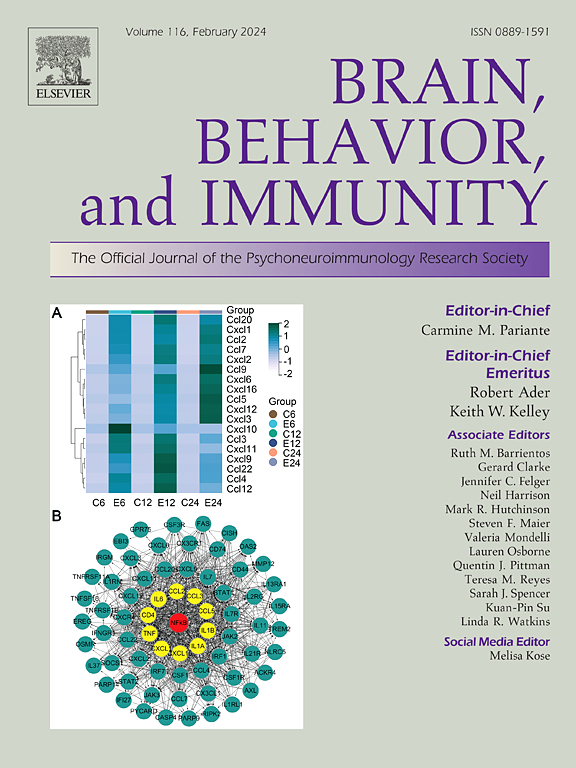Immunophenotyping schizophrenia subtypes stratified by antipsychotic response
IF 8.8
2区 医学
Q1 IMMUNOLOGY
引用次数: 0
Abstract
Immune dysfunction has been proposed to play a role in the pathophysiology behind the development and persistence of psychosis. Current immunophenotyping studies are limited by small sample sizes and the number of immune markers investigated. Pharmacological subtypes in schizophrenia based on antipsychotic response have been proposed, but few studies have investigated immunophenotypes in treatment-resistant schizophrenia. In this study, we perform comprehensive immunophenotyping on 196 subjects comprising 147 schizophrenia patients stratified by antipsychotic response (49 antipsychotic-responsive, 70 clozapine-responsive, 28 clozapine-resistant) and 49 healthy controls. We aim to identify significant immune cell populations associated with schizophrenia and increasing treatment resistance, as potential modulators of underlying psychosis and/or treatment response. Patients with schizophrenia were recruited and assessed on the Clinical Global Impression – Schizophrenia (CGI-SCH). Treatment response was defined as a rating of three (mild severity) or less on the CGI-SCH positive symptom item after at least 8 weeks of adequate antipsychotic or clozapine treatment. Peripheral blood mononuclear cells were collected and flow cytometry was performed to identify 66 immune cell populations. Differences in cell population proportions were compared between schizophrenia cases and controls, and across all 4 groups, with post-hoc pairwise comparisons. Mucosal-associated invariant T (MAIT) cells (specifically CD8 + and DN double-negative subsets), total, exhausted and memory CD8 + T cells, VD1 + ϒδ T cells, plasmablasts, IgG + B cells and conventional dendritic cells 2 (cDC2) were among the top cell populations downregulated in schizophrenia. We observed increased downregulation with increasing treatment resistance. Conversely, naïve and exhausted CD4 + T cells, CD4/CD8 ratio and CCR5 + CCR2 + HLA DR + Myeloid cells were found to be upregulated in schizophrenia — we observed increased upregulation with increasing treatment resistance. We show significant immunophenotypic differences between schizophrenia cases and healthy controls, and consistent trend differences across varying degrees of antipsychotic resistance. We also examined immune cell populations not previously reported in schizophrenia. Future studies may explore immune markers identified as potential biomarkers of treatment resistance, and clarify on the relationship between immunological changes and pharmacological subtypes in schizophrenia.
按抗精神病药反应分层的精神分裂症亚型免疫分型。
有人认为,免疫功能障碍在精神病发病和持续存在的病理生理学过程中扮演着重要角色。目前的免疫分型研究受到样本量小和所调查的免疫标记物数量少的限制。根据抗精神病药反应提出了精神分裂症的药理亚型,但很少有研究调查耐药精神分裂症的免疫分型。在本研究中,我们对 196 名受试者进行了全面的免疫分型,其中包括按抗精神病药反应分层的 147 名精神分裂症患者(49 名抗精神病药反应型、70 名氯氮平反应型、28 名氯氮平耐药型)和 49 名健康对照组。我们的目标是找出与精神分裂症和治疗耐药性增加有关的重要免疫细胞群,作为潜在精神病和/或治疗反应的潜在调节因子。我们招募了精神分裂症患者,并对他们进行了临床总体印象--精神分裂症(CGI-SCH)评估。治疗反应的定义是经过至少 8 周的充分抗精神病药或氯氮平治疗后,CGI-SCH 阳性症状项目的评分为 3 分(轻度严重)或更低。收集外周血单核细胞并进行流式细胞术检测,以确定 66 种免疫细胞群。通过事后配对比较,比较了精神分裂症病例和对照组之间以及所有 4 组之间细胞群比例的差异。粘膜相关不变T细胞(MAIT)(特别是CD8 +和DN双阴性亚群)、总CD8 + T细胞、衰竭和记忆CD8 + T细胞、VD1 + ϒδ T细胞、浆细胞、IgG + B细胞和传统树突状细胞2(cDC2)是精神分裂症中最主要的下调细胞群。我们观察到,随着治疗耐药性的增加,下调幅度也在增加。相反,我们发现在精神分裂症中,幼稚和衰竭的 CD4 + T 细胞、CD4/CD8 比率和 CCR5 + CCR2 + HLA DR + 髓样细胞上调--我们观察到随着治疗耐药性的增加,上调也在增加。我们发现精神分裂症病例与健康对照组之间存在明显的免疫表型差异,而且不同程度的抗精神病药耐药性之间也存在一致的趋势差异。我们还研究了以前未报道过的精神分裂症免疫细胞群。未来的研究可能会探索作为耐药性潜在生物标志物的免疫标志物,并阐明精神分裂症免疫学变化与药物亚型之间的关系。
本文章由计算机程序翻译,如有差异,请以英文原文为准。
求助全文
约1分钟内获得全文
求助全文
来源期刊
CiteScore
29.60
自引率
2.00%
发文量
290
审稿时长
28 days
期刊介绍:
Established in 1987, Brain, Behavior, and Immunity proudly serves as the official journal of the Psychoneuroimmunology Research Society (PNIRS). This pioneering journal is dedicated to publishing peer-reviewed basic, experimental, and clinical studies that explore the intricate interactions among behavioral, neural, endocrine, and immune systems in both humans and animals.
As an international and interdisciplinary platform, Brain, Behavior, and Immunity focuses on original research spanning neuroscience, immunology, integrative physiology, behavioral biology, psychiatry, psychology, and clinical medicine. The journal is inclusive of research conducted at various levels, including molecular, cellular, social, and whole organism perspectives. With a commitment to efficiency, the journal facilitates online submission and review, ensuring timely publication of experimental results. Manuscripts typically undergo peer review and are returned to authors within 30 days of submission. It's worth noting that Brain, Behavior, and Immunity, published eight times a year, does not impose submission fees or page charges, fostering an open and accessible platform for scientific discourse.

 求助内容:
求助内容: 应助结果提醒方式:
应助结果提醒方式:


